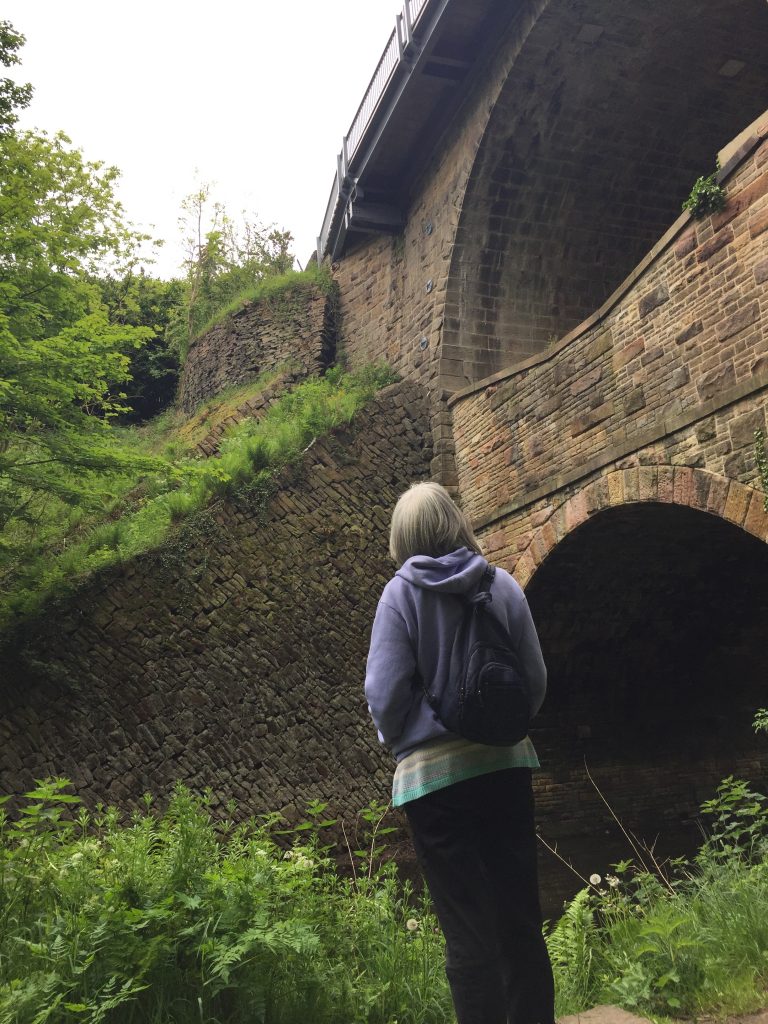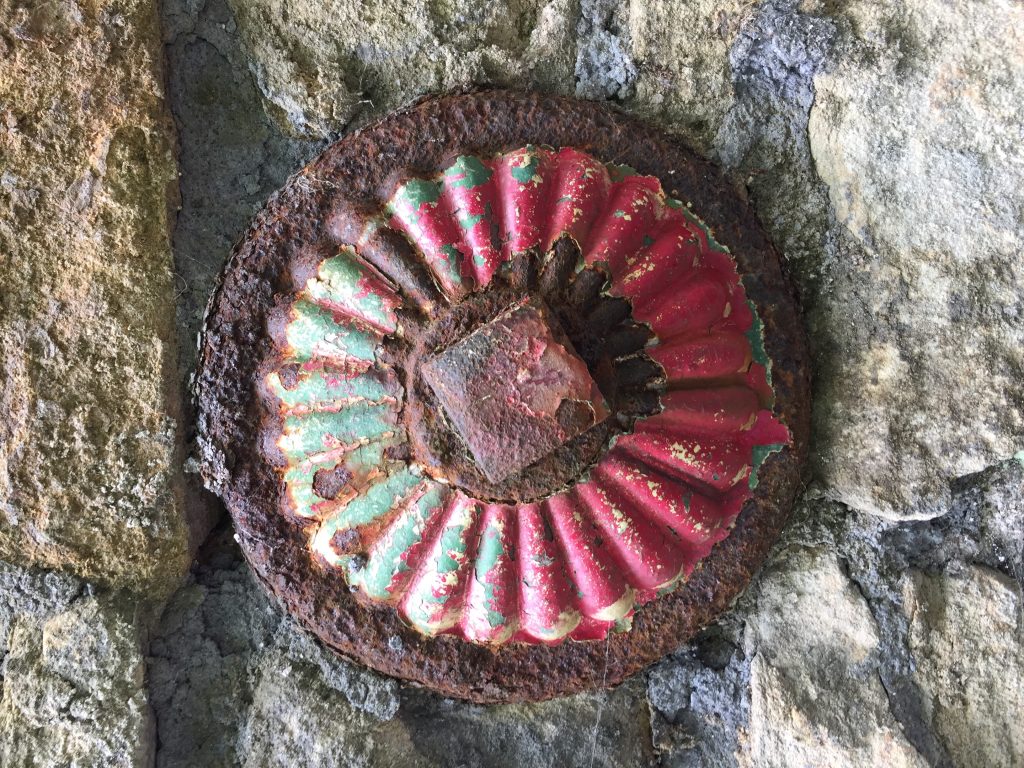Last week on my journey to Sheffield the train had stopped at New Mills Central station, a town bordering Derbyshire and Cheshire. As we’d slowed down approaching the station a deep gorge was visible adjacent to the station, and a walkway appeared to run the length of the river. Ruined mills lined the gorge walls. I did some online research and it beckoned for more exploration. So yesterday, with low clouds showering me with intermittent sprinkles, I found myself alighting from the train and immediately found a steep path, no doubt once cobbled but now tarred, taking me deep into the bottom of the gorge to river level.

The noise of the town’s traffic was completely drowned out by the cascades of water as it rushed along the river bed, interrupted by weirs from time to time. The sound echoed off the tall stone cliffs and massively impressive viaduct arches. A facade of a disused mill towered above a modern looking walkway clinging precariously to a massive stone wall reminiscent of the Great wall of Todmorden. The walkway is Torrs Millenium walkway and was completed in 1999 and a plaque close by is in memory of its chief engineer who was killed in the London bombing in 2015 while on his way to a Derbyshire County Council conference.
The vast edifice of Torr Vale Mill, just across the river there, started as a water-powered cotton mill in the 1780s. It was converted first to steam, then to electricity and spun its last yarn in 2000.




At one point a mill chimney had been built directly onto the cliff wall. The cliff attracts rock climbers. As I walked along the gorge was closed by several bridges both a lover levels just above the stream and at the highest level on top of the cliffs. I found myself wondering why, if the river had carved out this gorge, the cliffs showed no signs of being eroded by the water. Eventually when I got back home I found my answer on the discovering Britain website:
‘It is hard to believe today but the River Goyt once took an entirely different course. Where we stand now would have been nothing but solid sandstone. The change came 2.5 million years ago when the Earth went through a series of Ice Ages. The planet’s temperature dropped and vast areas were covered in huge ice sheets.Here at The Torrs, the titanic movement of an ice sheet swept along a huge quantity of boulder clay. Clay is impervious to water. This effectively dammed the previous course of the river. When the ice finally started to melt around 10,000 years ago, the newly resurgent Goyt was forced to find another route down towards the Mersey.
It found it through a line of weakness in the Woodhead Hill Rock. The easily-worked sandstone was just as easily eroded by the fast-flowing Goyt and Sett rivers, fed by all that melting ice. The result was this
swiftly cut, deep and narrow gorge.’ The water smoothed stone was quarried to provide the stone for the building of the mills in the gorge.


The other question I had was about the origin of the name of the town – New Mills. I presumed that one of the early mills had been destroyed by fire and then rebuilt as ‘new Mill.’ But no, I was completely wrong – as the same website informed me: ”The power of water had been harnessed along these rivers for centuries, chiefly for milling corn. Water was the obvious choice for driving the machines of the early Industrial Revolution. The name New Mills does not stem, as you might think, from the huge buildings we saw from up top. There is a record of a water-powered corn mill further up the River Sett as far back as 1390.”

When a second mill was built, nearer to The Torrs, it became known as ‘New Milne’. So, the growing town had already acquired its name when manufacturers eyed-up all this free water power during the 1780s. The stone for construction, as we have seen, was just to hand and easily worked. Quarrying cleared enough land to provide the first cotton mills with a large enough plot, so it really was a win-win situation. ‘

Emerging from the canyon I found myself in a large meadow peppered with buttercups and mayflowers. One unexpected find was a friendly llama!

Trying to find the canal which parallels the River Goyt came to nothing, having been told my someone on the trail that it was ‘on top of that hill above the meadow’ pointing up a steep hill. So heading back towards the walkway I thought I should take a look at the Shrub club

that I’d been told was worth a visit. It’s a bar/restaurant in a former mill. It certainly had an amazing location. It’s very much a wedding venue and I wondered how the participants and guests would negotiate the steep trails down the gorge.

Heading into the town centre of New Mills lunch was provided by Pride of the Peak. In the town’s main street I felt as if I’d just stepped back in time 40 years, and this feeling was certainly emphasised by the pub. There was just something about the decor with its cheap shiny decorations. This was further borne out by the tv channel playing in the lounge – 80’s and 90’s pop videos. I ordered a chicken, bacon and avocado salad which was enormous, but just at the side of the bar opposite the table was a glass refrigerator with all sorts of tempting deserts, and after glancing in their direction for an hour I succumbed to a trifle. However, it was served with a further plate of fruit and fresh cream. Wow!


Leaving the Pride of the Peak the next port of call was to be the canal which I’d failed to reach, the first time round. I passed a large factory reminiscent of a Lowry painting. It’s the current home of Swizzles sweet factory which makes Love Hearts and Refreshers.
The canal basin was full of barges. Further along the Peak forest canal a sign caught my eye – Beware Giant Hogweed. I thought that perhaps the weed fell into the water and disrupted the steering of the boats but – wrong again.

The giant weed is highly toxic to human skin and online there are horrendous photos of burns that people have suffered from touching the sap of the Giant Hogweed. Hmm.

Back home after a 9 hour adventure including 9 miles of walking and barking up the wrong tree three times!


Leave a Reply